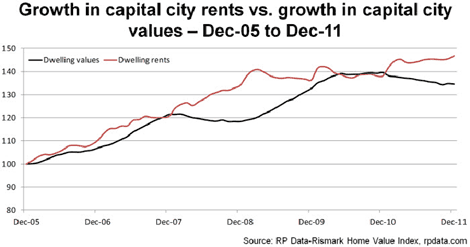This could be the year of rental growth

During times of slower property price growth, let’s be honest, property investors count on rising rents to boost their investment returns.
The fact is, since the beginning of 2006 rental growth across the combined capital cities has outpaced the growth in home values.
Rents outpaced capital growth
The following table from RP Data shows that over the last six years, capital city home values have increased by 34.5% compared with rental rates, which have increased by a total of 46.8%.
Click to enlargeNationally, rents have grown about 5% over the last year, with vacancy rates generally sitting below 2% due to strong demand from tenants and a limited supply of properties.
The rental markets are fragmented
Currently the Sydney, Perth, Canberra rental markets are particularly strong due to a low level on construction of new accommodation and this is expected to place an upward pressure on rentals.
On the other hand, while rents are still rising in Melbourne, Adelaide, Hobart and Darwin, the markets are not as tight.
According to Gerard Haines, department head of Metropole Property Management Sydney, his team in Sydney is experiencing strong demand from tenants, particularly in the inner west, where vacancy rates are less than 1%.
“This region is gentrifying and there is a strong demand from a wide demographic of tenants who want to live close to the CBD in these up-and-coming lifestyle suburbs.”
“There is also strong demand and restricted supply in Sydney’s eastern suburbs, and rents are likely to keep rising in these areas,” says Haines.
Peter O’Brien, head of Metropole Property Management in Melbourne, tells a different story.
“While the overall vacancy rate in Melbourne as reported by the REIV is around 2.4%, and there is strong demand from tenants for well located properties in Melbourne’s inner and middle ring suburbs, there are some pockets of Melbourne where the vacancy rate is double that and tenants have the upper hand. This is because there is abundant supply following a period of over exuberant construction by developers,” says O’Brien.
SQM Research reports a vacancy rate of around 8% in some western Melbourne suburbs such as Point Cook, Tarneit and Melton.
The Melbourne CBD is also suffering with an oversupply and the situation is likely to become worse with an estimated 5,000-7,000 apartments coming onto the market in 2103, with many of these in high-rise complexes.
To make matters worse, according to Charter Keck Kramer, there are currently 17,860 apartments under construction in Melbourne, with another 16,850 apartments still being marketed across Melbourne.
Competition for tenants from these projects, which have mainly been bought by investors, is likely to put a lid on CBD rental growth.
Rental growth is slowing
The latest figures from Australian Property Monitors show national weekly rents for houses remained steady for the first three months of the year and rents for units fell 1.1%.
While asking rents dropped in Melbourne and Adelaide, some rental markets are still performing strongly according to APM.
Year-on-year rent growth was highest in Darwin (+11.8%), Perth (+3.9%), Brisbane (+2.7%) and Sydney (+2%).
The bottom line
We are at that stage of the property cycle when capital growth is slower and rental growth is strong. But the divergent performance of our rental markets just goes to remind us that buying the right property in the right location is, as it always has been, the key to successful investing.
For your property investment to perform well in the long-term you need to own the type of property that will be in continuously strong demand by a wide range of owner-occupiers (who will push up the price of similar properties in the area) and tenants (who will pay you rent).
Michael Yardney is the director of Metropole Property Investment Strategists , a best-selling author and one of Australia's leading experts in wealth creation through property. He also writes the Property Investment Update blog.
